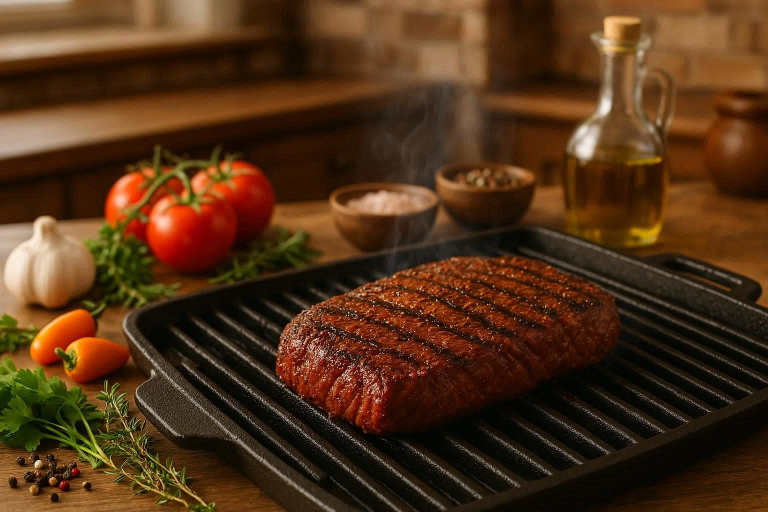London Broil is often misunderstood as a specific cut of meat, but it’s actually a cooking method. Traditionally, it refers to marinating and grilling or broiling a lean cut of beef, such as flank steak or top round. This method results in a flavorful and tender piece of meat when prepared correctly.
London Broil is a favorite for grilling and roasting because it’s incredibly versatile, packed with flavor, and cost-effective. It’s a great choice for family meals, BBQs, and even special occasions. The ability to marinate the meat helps enhance its natural taste, making it a great base for various seasonings and flavors. Plus, it’s often a more affordable option compared to other cuts of beef.
However, achieving tenderness with London Broil can be tricky. If overcooked or sliced incorrectly, it can become tough and chewy. The key to success lies in the right preparation, cooking method, and slicing technique. In this post, we’ll guide you step-by-step on how to cook a perfectly tender London Broil, so you can enjoy a mouthwatering meal every time.
What is London Broil?
London Broil is often misunderstood as a specific cut of meat, but in reality, it refers to a cooking method rather than a particular cut. The name “London Broil” typically applies to flank steak or top round, both of which are lean, flavorful cuts of beef. These cuts are chosen because they absorb marinades well and cook quickly, which is perfect for grilling or broiling.
The confusion comes from the fact that the term “London Broil” isn’t a standard cut like ribeye or sirloin. Instead, it refers to how the meat is prepared—marinated, cooked at high heat, and sliced thinly against the grain to maintain tenderness.
London Broil is known for its ideal texture when cooked correctly. It should be tender with a slight chew, but not tough or rubbery. Overcooking can turn this cut into something less enjoyable, which is why proper cooking is crucial. Cooking the meat to medium-rare or medium and then letting it rest helps maintain its juicy tenderness. And slicing it against the grain ensures each bite is easy to chew.
Preparing the London Broil for Cooking
Step 1: Choosing the Right Cut
The first step to cooking a perfect London Broil is choosing the right cut. While the name might be misleading, London Broil typically refers to two cuts of meat: flank steak and top round. Both are lean, flavorful, and benefit from the marinating and high-heat cooking method.
When shopping for your London Broil, visit your local butcher or grocery store and look for a fresh, bright-colored cut with minimal visible fat. The flank steak has long, grainy fibers, while top round is slightly thicker and leaner. Both cuts are perfect for the London Broil method, but flank steak often has a more intense beefy flavor.
Step 2: Marinating for Maximum Flavor
Marinating is a crucial part of the London Broil process. The goal is to add flavor and tenderize the meat, making it juicier and easier to chew. A good marinade should have a mix of acids, oils, and seasonings.
- Acidic Ingredients: Vinegar, lemon juice, or wine help break down muscle fibers, making the meat more tender.
- Oil-based Ingredients: Olive oil, soy sauce, or other oils help retain moisture and give the meat a juicy texture.
- Seasonings: Garlic, herbs, and spices enhance flavor. You can also add a bit of honey or sugar to balance the acidity.
Marinate the meat for at least 2-4 hours, but ideally, let it sit overnight for deeper flavor penetration. Don’t over-marinade, though, as acidic marinades can make the meat mushy if left for too long. A good rule of thumb is to marinate for no longer than 24 hours.
Section 3: Cooking Methods for London Broil
Method 1: Grilling
Grilling is one of the most popular ways to cook London Broil. 50 Time-Saving Recipes Start by preheating your grill to high heat (around 450°F). High heat helps you achieve that perfect sear on the outside while keeping the inside juicy.
Place the marinated steak on the grill and cook it for about 4-6 minutes per side, depending on the thickness and your desired doneness. Flip the steak only once to ensure even cooking. Use a meat thermometer to check for an internal temperature of 130°F for medium-rare or 140°F for medium.
Method 2: Broiling
If you don’t have a grill, broiling is a great alternative. Set your oven to broil, and place the steak on a broiler pan about 4-6 inches from the heat source. Broiling is similar to grilling, but the heat comes from above.
Broil the steak for 4-6 minutes per side, checking the temperature as you go. The thicker the steak, the longer you’ll need to cook it, so adjust accordingly. Broiling can be a bit quicker than grilling, but it still delivers that beautiful, caramelized crust.
Method 3: Pan-Seared & Oven-Finished
For those without a grill or broiler, this method is perfect. Start by pan-searing the steak in a cast iron skillet over high heat for about 2-3 minutes per side to get a good crust. Once seared, transfer the pan to a preheated oven at 400°F and roast the steak for 5-8 minutes, depending on thickness.
This method ensures the steak cooks evenly and retains its tenderness, as the oven heat finishes cooking it gently while the pan sear locks in moisture.
How to Achieve Perfect Tenderness
Achieving perfect tenderness with London Broil relies on precise cooking time and internal temperature. Since this cut is lean, it can quickly become tough if overcooked. The key is to cook it to the right internal temperature for your desired doneness.
For a medium-rare London Broil, aim for an internal temperature of 130°F, and for medium, target around 140°F. Use a meat thermometer to monitor the temperature, as this ensures the meat doesn’t get overcooked.
Avoiding overcooking is one of the most important tips for tenderness. London Broil cooks quickly, and even a couple of minutes too long can turn it from juicy to dry. Once it reaches your desired temperature, please remove it from the heat immediately.
After cooking, resting the meat is essential. Allow the London Broil to rest for 5-10 minutes before slicing. This lets the juices redistribute throughout the meat, keeping it tender and moist. Slicing it right away can cause the juices to escape, resulting in a drier texture.
With the right timing and resting, your London Broil will come out tender, flavorful, and ready to impress.
Slicing and Serving London Broil
The way you slice your London Broil can make all the difference in tenderness. To achieve the most tender bites, it’s important to slice against the grain. The grain refers to the direction of the muscle fibers, and cutting against it shortens those fibers, making the meat easier to chew. Make sure to slice thinly and at a slight diagonal for the best results.
When it comes to serving, London Broil pairs wonderfully with classic sides. You can’t go wrong with creamy mashed potatoes or a mix of roasted vegetables, such as carrots, potatoes, and Brussels sprouts. These sides balance the richness of the beef and add color to your plate.
To elevate your meal, consider adding a sauce or dip. A simple garlic butter sauce or a chimichurri can enhance the flavor of the steak. For something richer, try a mushroom gravy or béarnaise sauce to complement the beef.
London Broil is a versatile dish that pairs well with many sides and sauces, allowing you to get creative with your meal presentation and flavors. Whether for a weeknight dinner or a special occasion, it’s a meal sure to impress.
Common Mistakes to Avoid
To ensure your London Broil turns out perfectly tender and flavorful, it’s important to avoid a few common mistakes that many cooks make.
1. Overcooking or Undercooking
One of the biggest mistakes is either overcooking or undercooking the meat. Since London Broil is a lean cut, it cooks quickly. Overcooking will make it tough and dry, while undercooking can leave it chewy and unsafe to eat. To avoid this, use a meat thermometer to check the internal temperature and remove the steak once it reaches your desired doneness.
2. Not Marinating Long Enough
Marinating is key to enhancing flavor and tenderness, but under-marinating can lead to bland or chewy meat. For best results, marinate your London Broil for at least 2-4 hours, or up to 24 hours. This allows the marinade to penetrate deeply and tenderize the meat.
3. Slicing With the Grain
If you slice the meat with the grain, you’ll end up with long, tough fibers that are hard to chew. To maximize tenderness, always slice against the grain. This shortens the muscle fibers, making each bite much easier to enjoy.
Avoid these mistakes, and you’ll be well on your way to creating a perfectly cooked, tender London Broil every time.
Conclusion
In summary, making a perfect, tender London Broil starts with choosing the right cut, marinating it properly, and cooking it to the right temperature. Whether you grill, broil, or pan-sear, the key is to avoid overcooking and to slice against the grain for maximum tenderness.
We encourage you to experiment with different marinades and cooking methods to find what works best for your taste. The beauty of London Broil lies in its versatility—you can customize the flavors with a variety of marinades and sauces, making it a dish that suits any occasion.
Once you’ve mastered the basics, London Broil can easily become a staple in your cooking repertoire. It’s a flavorful, cost-effective choice that can be enjoyed time and time again, whether for weeknight dinners or special celebrations. With a little practice, you’ll be cooking perfect, tender London Broil every time!
FAQs
How should London Broil be cooked?
London Broil is best cooked using high heat methods like grilling, broiling, or pan-searing. To achieve tenderness, it’s important to cook it to the right internal temperature (around 130°F for medium-rare or 140°F for medium) and slice it against the grain to break up the muscle fibers.
How long does it take to cook a 2 lb London Broil in the oven?
If you’re broiling a 2 lb London Broil, it typically takes about 4-6 minutes per side under high heat. The exact time can vary depending on your oven and the thickness of the meat. Always check the internal temperature for the best results.
Does London Broil get more tender the longer you cook it?
No, London Broil doesn’t get more tender the longer you cook it. In fact, overcooking can make it tough and dry. It’s best to cook it to medium-rare or medium for optimal tenderness.
What are common mistakes when cooking London Broil?
Some common mistakes include overcooking, undermarinating, and slicing with the grain. To avoid these, make sure to marinate for a few hours, monitor the internal temperature, and always slice against the grain to keep the meat tender.

